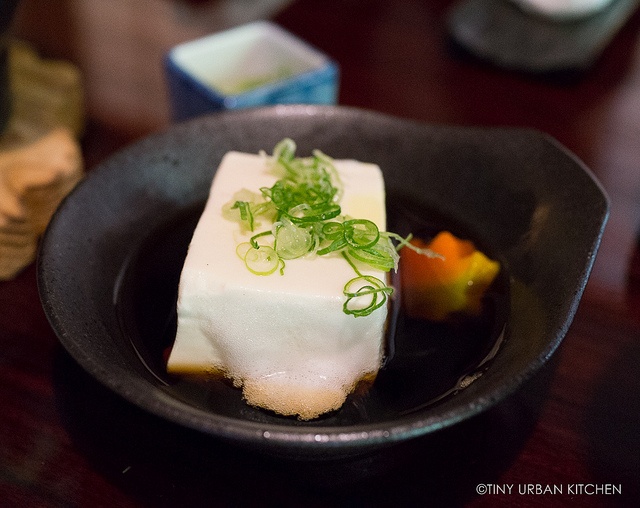 This is the sixth post in the Tokyo - Kyoto - Osaka series. Other posts in this series include the intro post: Tokyo, Kyoto, and Osaka, Matsugen (soba), Sushi Iwa, Ramen Honda (Tokyo Ramen Street), Ryugin, and Omen.
This is the sixth post in the Tokyo - Kyoto - Osaka series. Other posts in this series include the intro post: Tokyo, Kyoto, and Osaka, Matsugen (soba), Sushi Iwa, Ramen Honda (Tokyo Ramen Street), Ryugin, and Omen.
When in Kyoto, you have to try the tofu.
Tofu is one of Kyoto's specialties, perfected by Buddhist vegetarian monks over the centuries. The tofu artisans in Kyoto are passionate and extremely serious about their craft.They use century old techniques to create perfect blocks of fresh, silky, and surprisingly flavorful tofu that's nothing like the bland bricks found in the industrial mass-produced variety.

Kyoto's tofu is widely regarded as the best in Japan, and Shoraian's is considered the best. It was in the quest for this magical, ethereal tofu that I took my friends on a forty-five minute walk, including a hike through a mountain path and up numerous stone steps, in order to reach this special place.
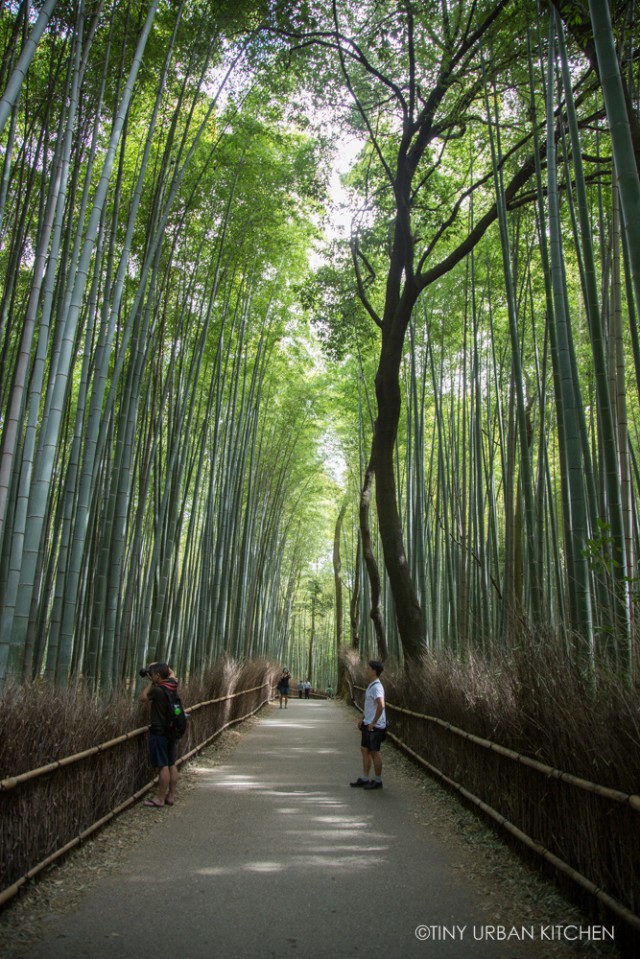
Shoraian is not your typical Japanese restaurant.
It's located in Arashiyama, a popular recreational area in Western Kyoto well known for its beautiful fall foliage, spring cherry blossoms, and stunning bamboo forests.
Not only is it on the western edge of Kyoto, you also can't get to the restaurant by car. Or by any wheeled vehicle, in fact. Shouraian is perched on the edge of a mountain overlooking the beautiful Oi River. You must take a short hike along a dirt path before climbing several flights of stone steps to reach this little oasis tucked away in the trees.

If you're already at the bamboo forest, there are many ways to get to the restaurant. The most direct way involves hiking through various winding trails towards the restaurant. We had read enough warnings from other travelers saying they got lost this way, so we chose not to risk it.
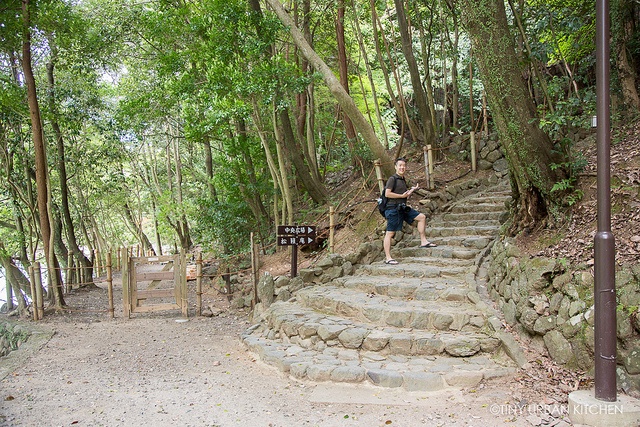
Instead, we walked along the river (very straightforward!) until the paved path ended. We continued following a dirt path until we reached a dead end where we saw a sign leading up to the restaurant (see Bryan pointing above). At this point, there are many signs which lead you towards the entrance.
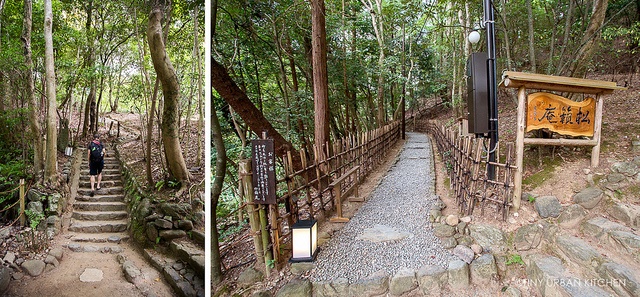
Go up a series of steps, and then another. After a few more steps, hang a left into this gravel pathway. It's useful to know the Japanese characters for the restaurant, since none of the signs are written in English. It took us about 45 minutes to walk from the bamboo forest to the restaurant because we took the longer, more circuitous but easier route.
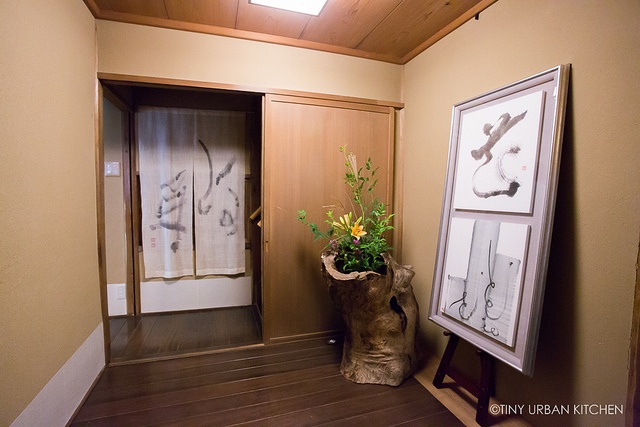
Upon entering, we immediate noticed a lot of hanging brushstroke art. The owner of the restaurant is also an artist, and really enjoys Japanese calligraphy.
And then they showed us our table.
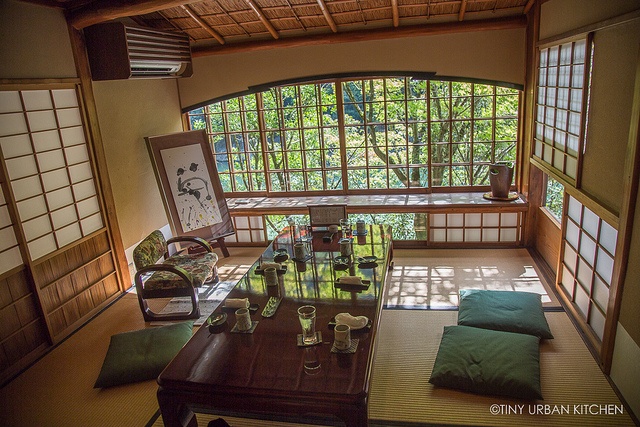
I almost gasped.
Our own private tatami room? I later found out that every table has a view of the scenic river. It's serene, peaceful, and very relaxing.
We had an option of three different types of tasting menus. The Shoyo is the least expensive, costing 3800 JPY (about $38 USD), and includes an appetizer, a smaller assorted specialties plate, "yudofu" (tofu hot pot), agedashi tofu, rice and pickles, and dessert.
The Shorai costs 4600 JPY (about $46 USD), and includes everything from the Shoyo plus an additional special item and a "Kyo-ryori seasonal selection".
The Shofu costs 5800 JPY (about $58 USD), and includes everything from the Shorai plus toyuba tempura, tofu gratin with namafu, and a mini-steak of wagyu beef. Additionally, it includes unlimited refills for the yudofu.
Since we had a party of four, we though it would be fun to order all three sets just to see exactly how they differed.
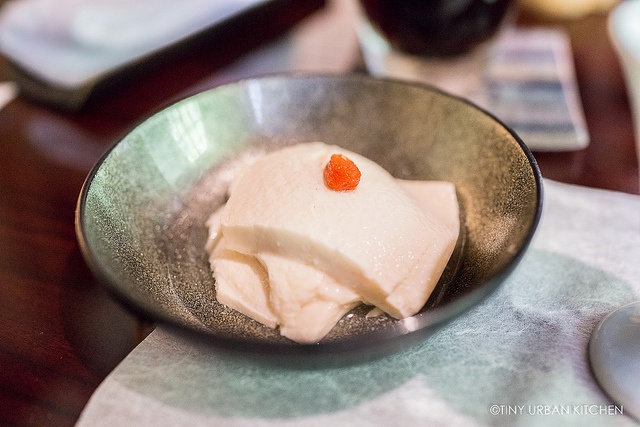
I loved our appetizer, a delicate, creamy tofu "burrata". It was soft, silky, and custard-like, so light and delicate it could be easily eaten with a spoon. This came with all three set menus.
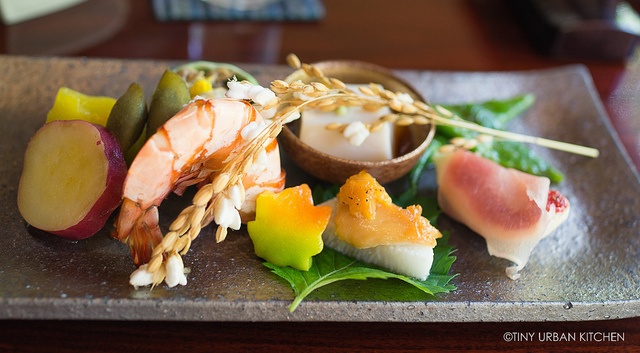
The next course was the "Assorted Specialties Plate", and included several artfully presented tiny bites. Pictured above is the platter from the 3800 JPY Shoyo menu: a boiled Japanese sweet potato slice, boiled shrimp, a leaf-shaped wheat gluten (namafu), Japanese mountain yam (yamaimo) topped with white miso, fresh fig slice topped with prosciutto, kabocha squash, boiled fresh soy beans (edamame), and a cake made from a mixture of wheat gluten and tofu.
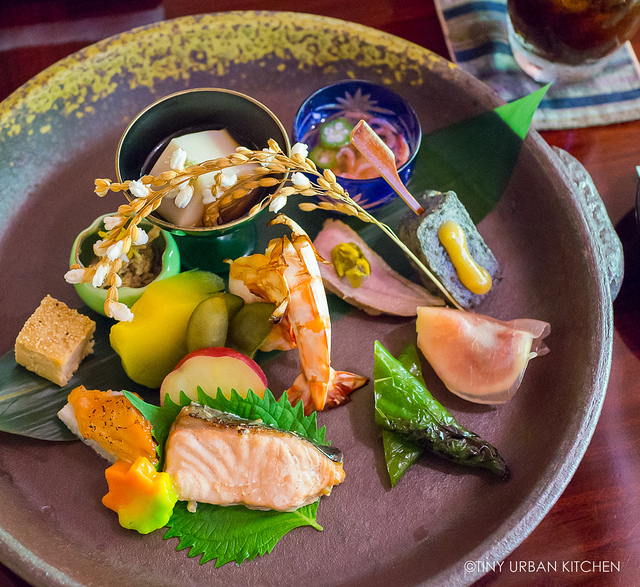
The same "Assorted Specialties Plate" from the mid-priced Shorai and higher priced Shofu menus included many of the same pieces served in the Shoyo menu, but also added other special items, such as a black sesame mochi skewer topped with white miso, a piece of cooked salmon, another piece of fish, a small vegetable salad tossed in a sesame paste dressing, and a grilled Shisito pepper.
The sheer variety of food so artfully presented on the plate was impressive. Though some items (like the salmon, shrimp, and edamame) were relatively unexciting, other items (like the wheat guten, tofu, or mochi-based little bites) were unusual and fun to try. I think the wheat-gluten tofu block was one of my favorites.
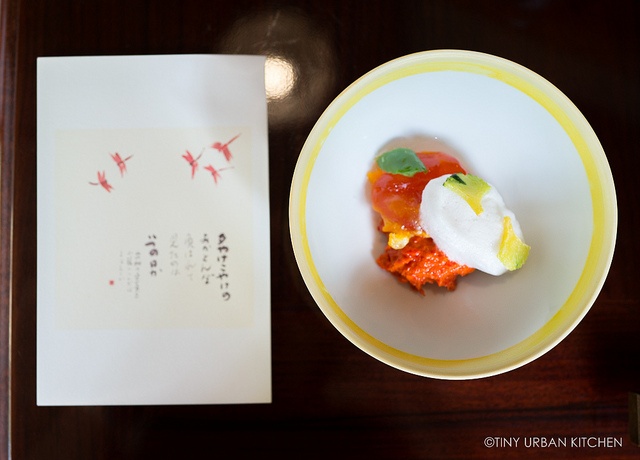
The next course, called Sunrise, was the "Kyo-ryori Seasonal Selection", which basically translates to Kyoto Cuisine Seasonal Selection. It was served alongside a postcard with the poem which inspired the dish. The poem, written in calligraphy by the restaurant's owner, is about the sun, and the dish represents the sun with its various components.
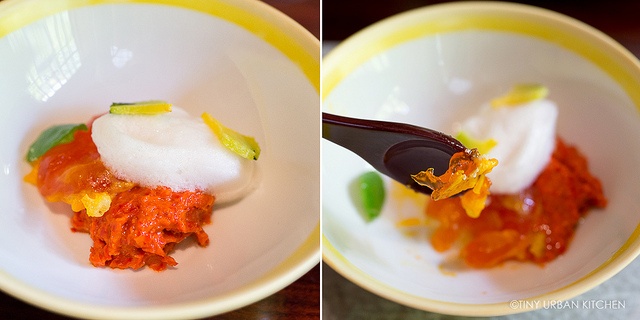
This was one of my favorite dishes. I loved the dense, gelatinous orange egg yolk combined with the intense red pepper sauce. I'm not sure what they did to the egg yolk, but the resulting texture was really unique. It was dense and thick, almost jamlike in texture but savory in flavor. It sort of reminded me of the gooey orange-yolked eggs you find in Japanese ramen. The red components were topped with a white foam and tiny little gingko shaped chips.
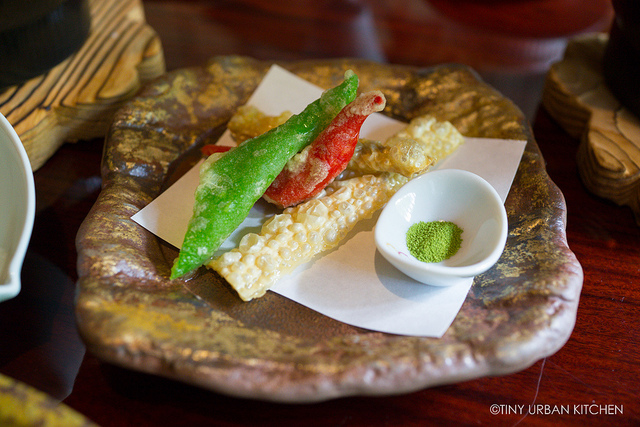
I also loved the next course, Toyuba Tempura, which is only available as part of the most expensive Shofu tasting (5800 JPY). Yuba is made by harvesting the thin film that forms at the top of a a boiling pot of soy milk. These skins are collected and dried to form yuba, which can then be deep fried into tempura. The toyuba tempura was served alongside a couple pieces of vegetable tempura.
These were delicate and crispy. We dipped them into a tiny bowl filled with matcha powder and salt.
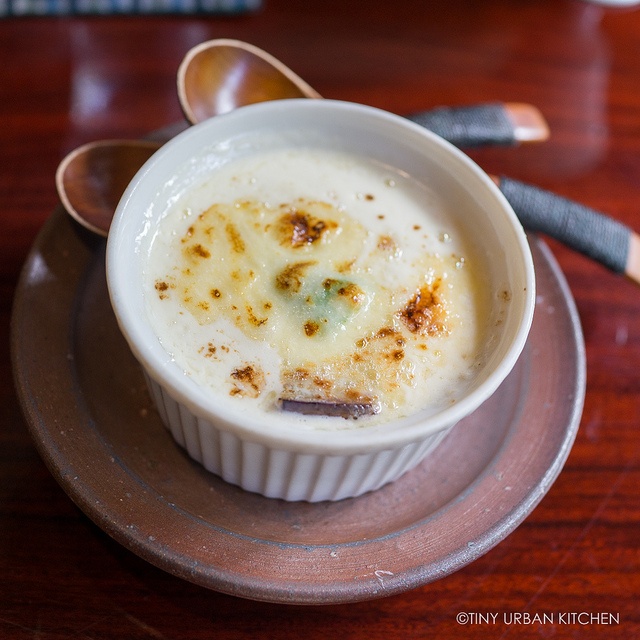
The next dish, Tofu Gratin with Namafu, is also only available as part of the most expensive Shofu tasting (5800 JPY). It's unlike anything Japanese I'd ever had before. Essentially, it's a ramekin filled with a cheese and soy cream custard filled with eggplant and a sesame mochi namafu (wheat gluten). I was surprised but the cheesy, soy cream flavor combination worked. It was very rich and creamy, but not too salty, which I liked. The wheat gluten inside added a nice, chewy texture.
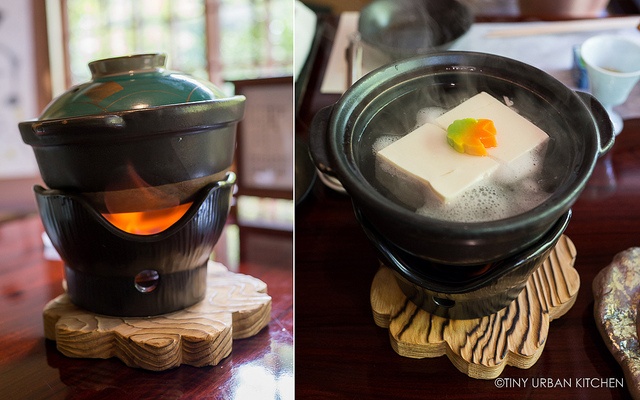
And then it was time for what they call "Yudofu", or tofu hot pot. It's actually a really simple dish. I believe the simple preparation allows you to actually taste the inherent flavors of the tofu. You taste the fresh, soy flavors.
Our server came by to light our individual tofu pots.

Once the tofu blocks were hot, we just ate them with a small amount of soy sauce and thinly sliced scallions. The tofu was excellent. It was luxuriously silken soft and light. The Shofu tasting includes unlimited refills of this delicious tofu.
But most definitely save room, because the next course, also only part of the Shofu tasting, is the Mini Steak of Wagyu Beef. The breed of the Wagyu beef we had was Hida beef, which comes from black haired Japanese cattle raised in the Gifu prefecture for at least 14 months. All Hida beef needs to be certified with a yield score of grade A or B and firmness levels 3, 4, or 5 (see my brief aside about Japanese beef grading in my Le Cirque post for more details).
This beef was simply grilled to a perfect medium rare and served over grilled eggplant and topped with spring onions. It was beautiful marbled, juicy and rich. In short it was excellent.
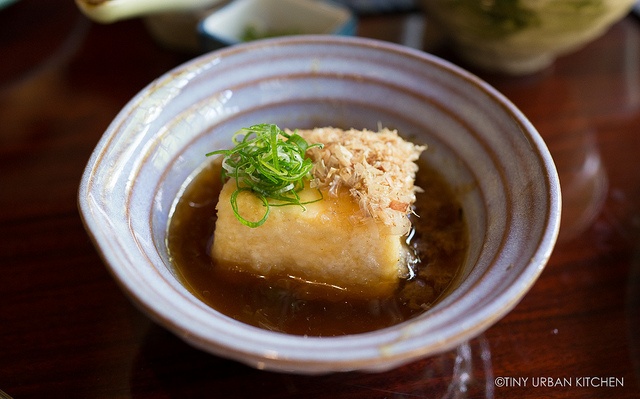
The Agedashi Tofu, deep fried tofu served in a dashi-based brothi, is part of all three tasting menus. I thought this was pretty good, though it did not necessarily blow me away. I may even dare say I've enjoyed this specific dish more in other restaurants. It was still perfectly enjoyable, though, and since I love this dish in general, I still happily ate it up.
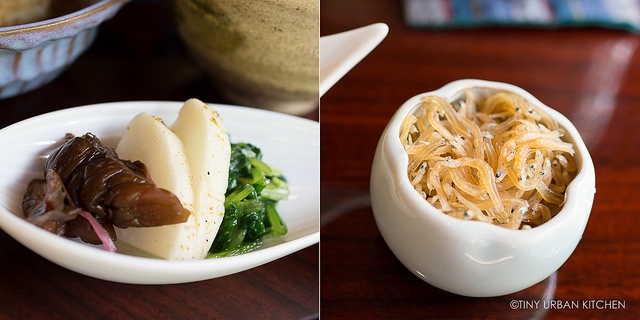
Finally, the meal ended with Rice + Pickles, which is a part of every tasting menu. We also all received a small bowl full of tiny fish tossed in Sichuan peppercorn powder.
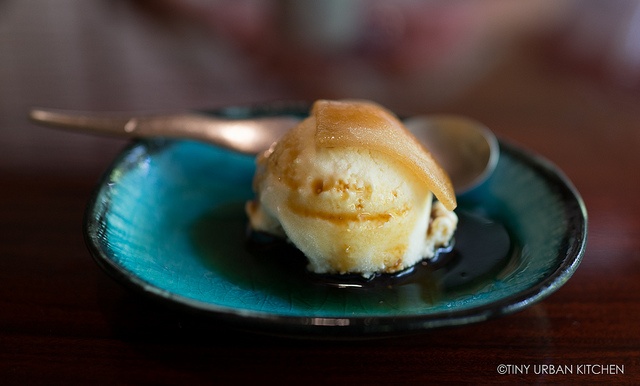
For dessert, we had a phenomenal Tofu Ice Cream topped with a tiny sheet of cinnamon flavored mochi. Wow. I absolutely loved this course too, and I longed for more than just a tiny scoop (which is all we got). I loved the strong soy flavor. It reminded me of the perfect, intensely flavored soy milk made into an ice cream.
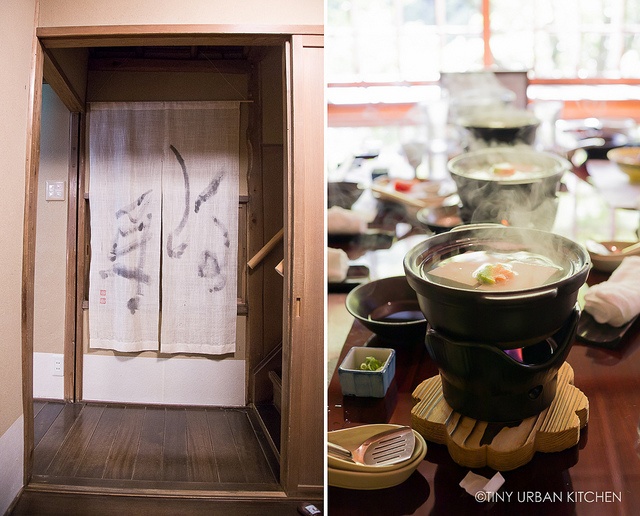
All in all, it was a very excellent meal. I liked how it was largely vegetarian, but still incorporated just enough meat to make it very filling. After trying all three, I would recommend the Shofu, which comes with the most interesting variety of tofu prepared in many, many ways. I was afraid of ordering the Shofu mostly because I was afraid it would be too much food. In reality, I think it's probably OK.
A sad aside, but Bryan actually got sick during out trip and had a really bad stomachache during this meal, so he ended up not eating at all. However, we felt bad taking up a seat, so we ordered four tasting menus (Two Shofus, one Shorai, and one Shoyo). Even though Bryan didn't eat, the three of us managed to almost finish all of the food. Yes, we were stuffed, but that also tells me that their normal portion size may be something I could actually handle.
I highly recommend this restaurant. I think it's the best bang for buck when it comes to everything. Where else can you get such a beautiful and authentic Japanese "kaiseki" experience with multiple, artfully decorated courses, a private tatami room, gorgeous views of the river, and really excellent food all for between $38-$58 a person? Keep in mind that really high-end kaiseki experiences usually run in the $100-$300 range. Compared to that, this is a steal.
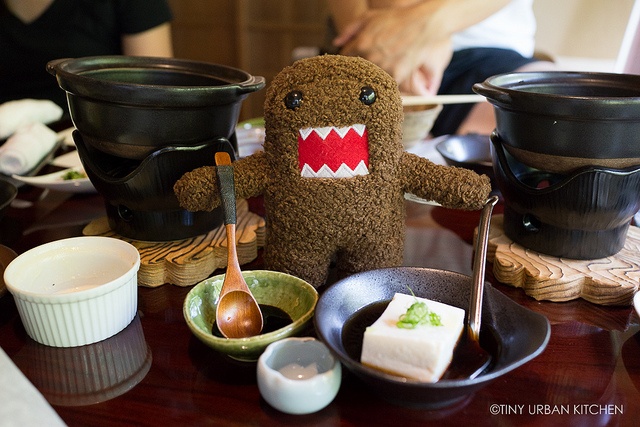
Other Tips
You can make reservations and you should. There are a limited number of tatami rooms and they book up reasonably quickly. I think I booked mine a little less than a month before arriving in Kyoto.
I've mentioned this earlier in the post, but please note that you do need to sort of hike to this location. It's not particularly difficult (equivalent to a few flights of stairs), but it's definitely not wheelchair friendly or anything like that. If you take a cab close to the entrance, you probably don't need to walk more than 5-10 minutes to get to the restaurant. We walked 45 minutes because we had been visiting the bamboo forests earlier in the day.
At least one person should order the Shofu. Except for the silken tofu appetizer and the actual Yudofu (hot pot), I found most of the courses from the Shoyo to be more ordinary. My favorite, more interesting dishes came from the Shofu, such as the Toyuba tempura, the "Sunrise" egg dish, and the Wagyu beef. I think it's worth the extra $20 USD for at least one person at the table to get the Shofu.

Here are the menus written out for your reference.
Enjoy!
Shoyo [3800]
Appetizer
Assorted specialties plate
Yudofu
Agedashi tofu
Rice and pickles
Dessert
Shorai [4600]
Appetizer
Assorted specialties plate
Special Item
Kyo-ryori seasonal selection
Yudofu
Agedashi tofu
Rice and pickles
Dessert
Shofu [5800]
Appetizer
Assorted specialties plate
Special Item
Kyo-ryori seasonal selection
Toyuba tempura
Tofu gratin with namafu
Mini-steak of wagyu beef
Yudofu (Refills available)
Agedashi tofu
Rice and pickles
Dessert
All Rights Reserved













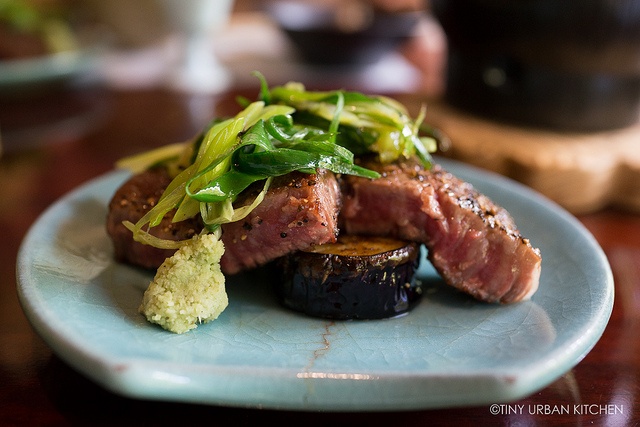
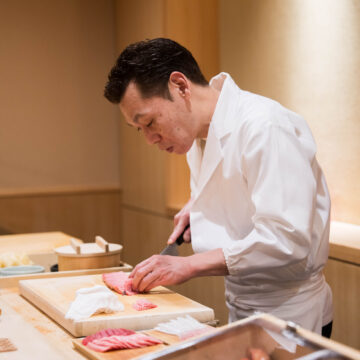
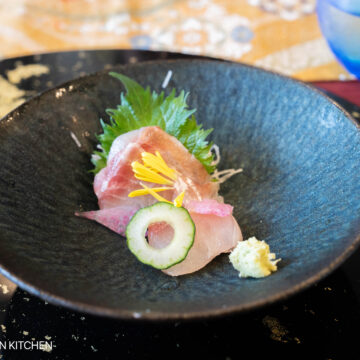
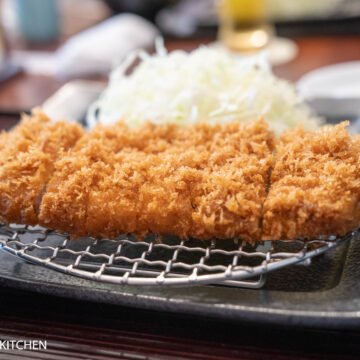
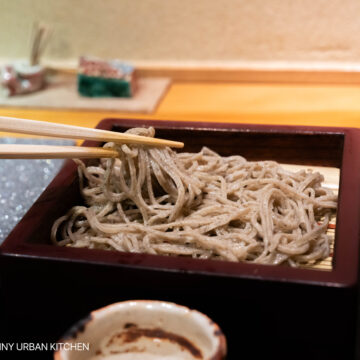
[…] kaiseki e o meu marido não curte tanto tofu assim, então passamos. Mas através deste post da Tiny Urban Kitchen, eu morri de vontade de ir lá. Vai ficar pra próxima. De lá, pegamos um ônibus e fomos para o […]